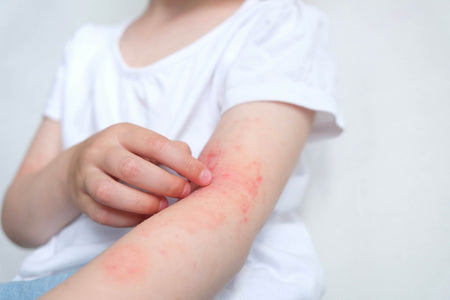- Allergies can lead to sinus infections by causing inflammation that blocks mucus drainage.
- Sinus infections often cause facial pain, pressure, and reduced sense of smell, while allergies mainly cause sneezing, itching, and watery eyes.
- Manage allergies by avoiding triggers, using air purifiers, and keeping humidity in check.
Imagine this: a seemingly harmless bout of sneezing and congestion stretches into days, maybe even weeks. You assume it's just allergies, triggered by pollen or dust mites. But then, your mild symptoms escalate — your face aches, your head feels heavy, and your nose won’t stop running.
Could your allergies have developed into something more? Could they have caused a sinus infection? In this article, we’ll learn the connection between these conditions and how one might lead to the other.
What is a Sinus Infection?
A sinus infection, also known as sinusitis, is an inflammation or swelling of the sinuses. These are the air-filled spaces behind the forehead, nose, cheeks, and eyes.
The inflammation prevents mucus from draining properly, which leads to discomfort and potential complications if left untreated. Sinus infection can be acute (short-term, and usually clears up within 7-10 days) or chronic (lasting more than 12 weeks) even when treated [*].
Can Allergies Cause Sinus Infection?
Allergies can contribute to sinus infections. When allergens like pollen, dust mites, or pet dander trigger an allergic reaction, they cause inflammation and swelling of the nasal passages and sinus lining.
The inflammation that’s present can block mucus drainage, and this creates an environment conducive to infection. Although allergies themselves do not directly cause infections, the resulting congestion and mucus buildup can promote the growth of bacteria or other pathogens.
People with weakened immune systems are more susceptible to developing sinus infections. Conditions such as diabetes, HIV, or the use of immune-suppressing medications can increase the risk of sinus infections due to a compromised immune response [*].
Related: Are Sinus Infections Contagious?
Other Causes of Sinus Infection
Sinus infections can be caused by various factors beyond allergies. Here are some common ones:
- Viral infections, such as the common cold
- Bacterial infections
- Fungal infections (less common, but may develop in people exposed to environments with high levels of mold)
- Nasal or sinus structural anomalies, such as a deviated septum or nasal polyps
- Exposure to irritants, such as chemical fumes, pollution, or strong odors
- Weather changes (fluctuations in temperature or humidity)
- Swimming or diving (these can introduce water into the nasal passages, which may contain bacteria or other microorganisms)
Each of these factors can increase a person’s risk of sinus infections either by introducing pathogens or creating conditions that allow pathogens to thrive.
Sinus Infection vs. Allergies
Sinus infections and allergies can have overlapping symptoms, but there are key differences that can help you differentiate between the two:
| Sinus Infection | Allergies | |
| Symptoms | Nasal discharge, facial pain or pressure, headache, reduced sense of smell and taste, fever, fatigue, and cough | Nasal discharge, sneezing, itchy eyes, itchy nose, itchy throat, and postnasal drip. |
| Onset | Sinus infections can follow a cold or develop suddenly. | Allergies often occur in response to specific triggers and may follow a predictable pattern, especially with seasonal allergies. |
| Duration | Sinus infections often last for a few weeks, especially if bacterial. | Allergies can persist as long as you’re exposed to the allergen. Seasonal allergies, for instance, may fluctuate for weeks or months during certain times of the year. |
Related: Allergies vs. Colds: Which is It?
How to Prevent Sinus Infection from Allergies
Preventing sinus infections related to allergies requires managing both your allergies and sinus health. Here are some strategies you can follow:
- Identify and avoid allergens. Determine what triggers your allergies and minimize exposure. For example, if you're allergic to pollen from trees, grasses, or weeds, minimize exposure by keeping windows closed during high pollen seasons, especially on windy days.
- Use air purifiers. Install HEPA filters in your home to reduce airborne allergens. HEPA filters can trap 99.97% of airborne particles as small as 0.3 microns, including pollen, dust mites, pet dander, and mold spores [*].
- Keep humidity in check. Maintain indoor humidity levels between 30-50% to prevent mold growth and reduce dust mites. Place a hygrometer in key areas like the bedroom, bathroom, or basement to monitor indoor humidity.
- Clean regularly. Dust and vacuum your home frequently. Many vacuums now come with built-in HEPA filters to help reduce allergens, and some designs make it easier to vacuum hard-to-reach places.
- Wash bedding and curtains. Clean these items regularly in hot water. This is an effective way to remove allergens like dust mites, pet dander, pollen, and mold spores that can accumulate in fabrics.
- Use nasal irrigation. This involves flushing the nasal passages with a saline solution to remove allergens, mucus, and debris. Doing this regularly can help prevent sinus infections by keeping the sinuses clear.
- Stay hydrated. Proper hydration helps keep mucus thin and more easily cleared from the nasal passages and sinuses. Water is the best choice, but herbal teas, broths, and diluted fruit juices can also help you stay hydrated. Avoid excessive caffeine and alcohol.
- Avoid Smoking. Smoke can irritate the sinuses and exacerbate allergic reactions [*]. Make sure that your living spaces are smoke-free to prevent exposure to secondhand smoke, which can also irritate the sinuses and worsen allergy symptoms.
- Take allergy medications. Use antihistamines or nasal corticosteroids as recommended by your healthcare provider to control allergic reactions. An all-in-one nasal spray like Allermi can offer better relief than other commercially available treatments, thanks to its formula that is adjusted as needed based on a person’s allergy symptoms and their severity.
- Protect yourself outdoors. Pollen can stick to your skin, hair, and clothes while you're outside. Showering and changing clothes after spending time outdoors helps remove pollen from your body and reduces the risk of bringing allergens inside. It’s a simple step that can help minimize allergy symptoms.
When to See a Doctor
See a doctor if your symptoms persist for more than 10 days without getting better, worsen despite using over-the-counter treatments, or if you experience severe pain, swelling, or changes in vision
Additionally, if you have frequent episodes of sinusitis or if your symptoms greatly impact your daily life, seeking medical advice can help determine the best course of treatment and address any underlying issues.
The Bottom Line
Knowing the relationship between allergies and sinus infections helps you better handle and prevent these problems. Make your home environment as allergen-free as possible and keep track of your symptoms so that you can easily identify triggers.
Identifying symptoms early and taking preventive actions can lower your chances of developing a sinus infection and manage your discomfort effectively.
References:
- Acute sinusitis - Symptoms and causes - Mayo Clinic. (2023, August 29). Mayo Clinic. https://www.mayoclinic.org/diseases-conditions/acute-sinusitis/symptoms-causes/syc-20351671
- Overview: Sinusitis. (2021, February 23). InformedHealth.org - NCBI Bookshelf. https://www.ncbi.nlm.nih.gov/books/NBK279485/
- What is a HEPA filter? | US EPA. (2024, March 5). US EPA. https://www.epa.gov/indoor-air-quality-iaq/what-hepa-filter
- Grillo, C., La Mantia, I., Grillo, C. M., Ciprandi, G., Ragusa, M., & Andaloro, C. (2019). Influence of cigarette smoking on allergic rhinitis: a comparative study on smokers and non-smokers. PubMed, 90(7-S), 45–51. https://doi.org/10.23750/abm.v90i7-s.8658









